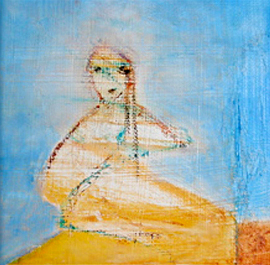Seeking One’s True Self at the Altar

“Philosophy of Freedom #8” by Laura Summer
In the Sunday Service for the Children, we hear that we have come to earth to learn and to work. We hear that human life becomes desolate without enlivening force of love in our work. We hear that Christ is love’s Teacher. For the children, a direction and focus for any life is gently indicated—learning to develop love as a capacity.
One can see the communion service for adults, the Act of Consecration of Man, as an extension of the path suggested in childhood. For, by its very nature, this Act is an offering of self to God. We offer our purest thoughts, our heart’s love, and a will devoted to Him, to Him who is the very essence of love. We perform an act that He asked us to do in memory of Him—the offering in gratitude of substances of earth—bread, water, wine, to our Father, so that He can be present in them.
We bind our noble thoughts, feelings and devotion to the substances that we, too, are offering, noting that we do so in connection with the working of the Trinity. We pray that the Son God be the creative force in us. We pray for the gift of the creating fire of love.
Christ comes to dwell in them, to concentrate His power in them, in such a way that, through taking in His substances in communion, we can take the creating fire of His love as well, and He can be present in us. He, whose whole life was Love incarnate, sacrifices Himself ever and again for our well-being, for the nourishment and strengthening of the creating power of love in us. Christ dies again and again. But He, the essence of Love, rises again in the hearts of those who give Him a dwelling place.
Our truest, deepest self, our true being, resides in this capacity to develop creative love. Our true self is capable of transforming our narrow egotism into a broader concern for the furtherance of the world. This capacity exists in us as potential, as a seed planted in us by God. At the altar, in any of the sacraments, but especially in the Act of Consecration of Man, this potential to develop love, the characteristic of our truest self, is nurtured and strengthened.
Paul says, ‘your life is now hidden with Christ in God’. Col 3:3 Our true being, our true creative potential, resides with Christ. At the altar we practice offering ourselves to Him in love, taking Him into our selves. At the altar, we are nurturing and developing the life of our true self, with His help. For our true self is Christ, creating Love, in us.
